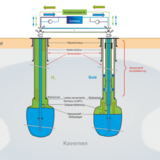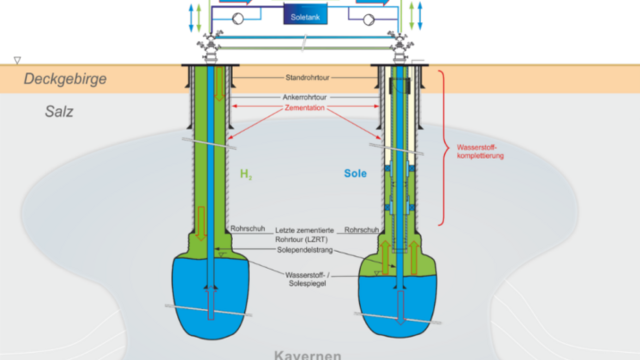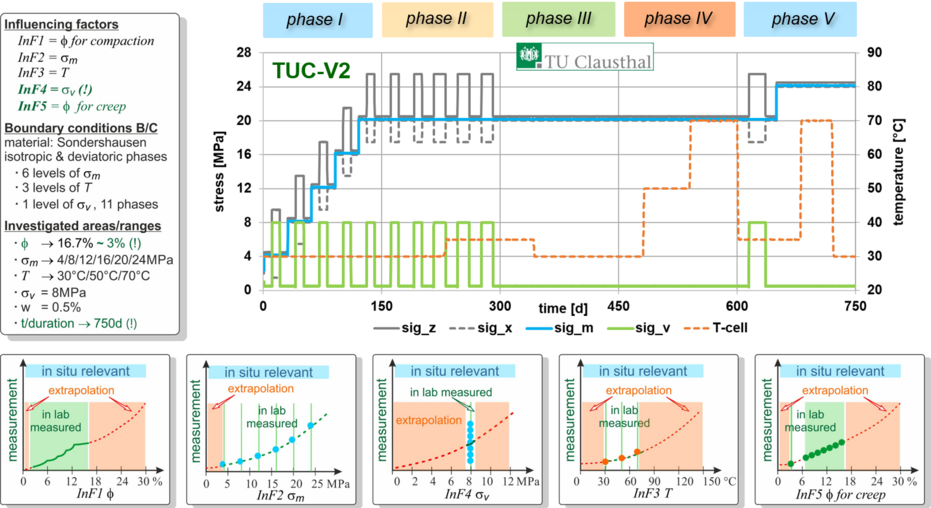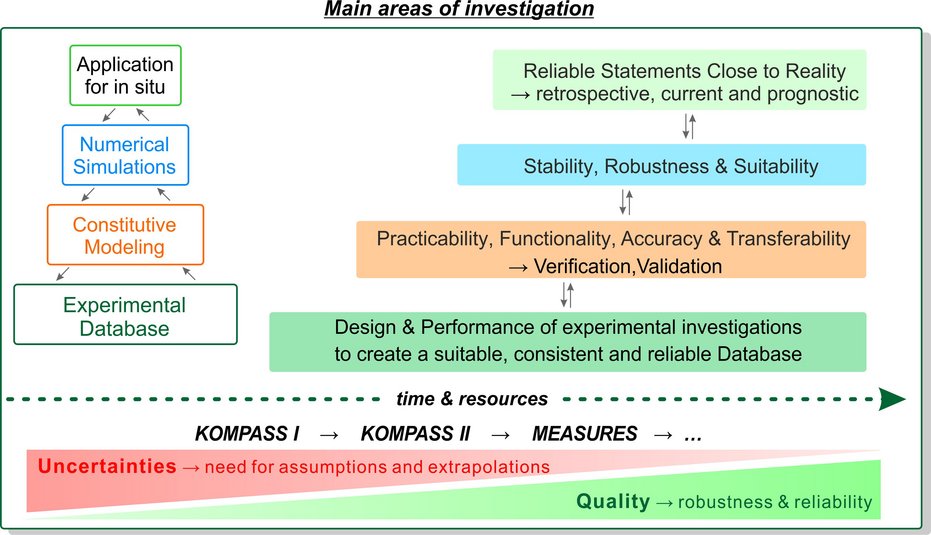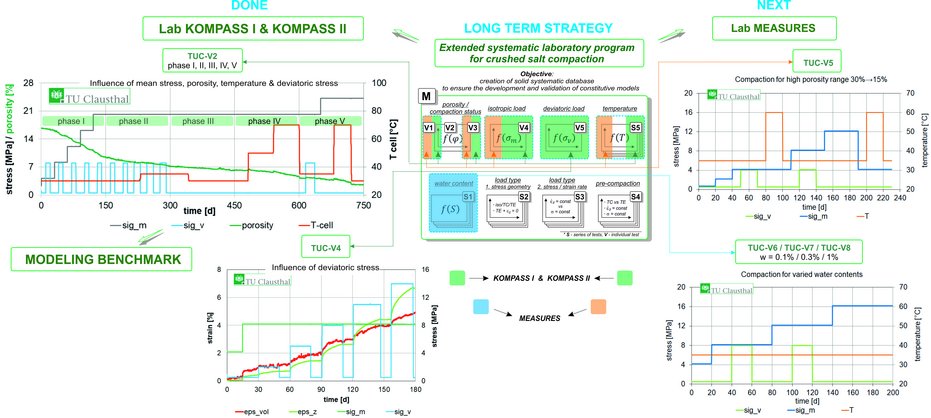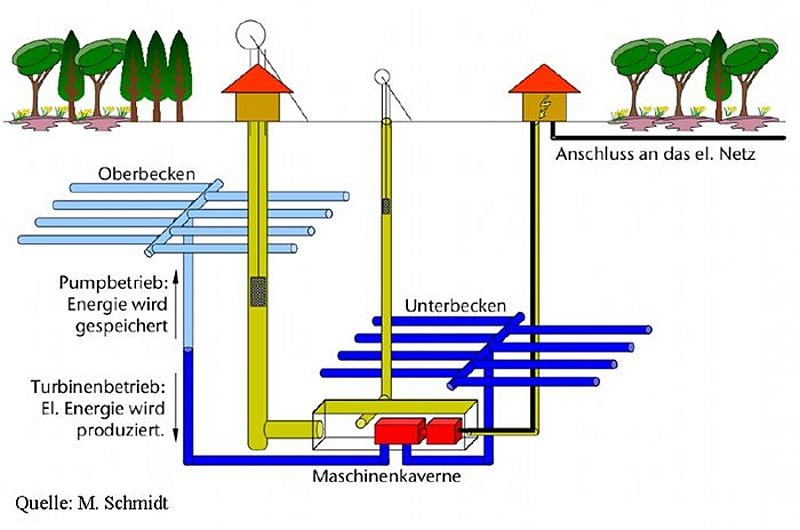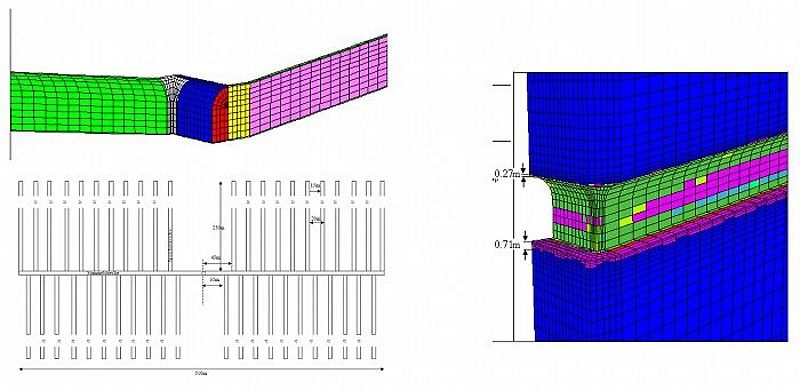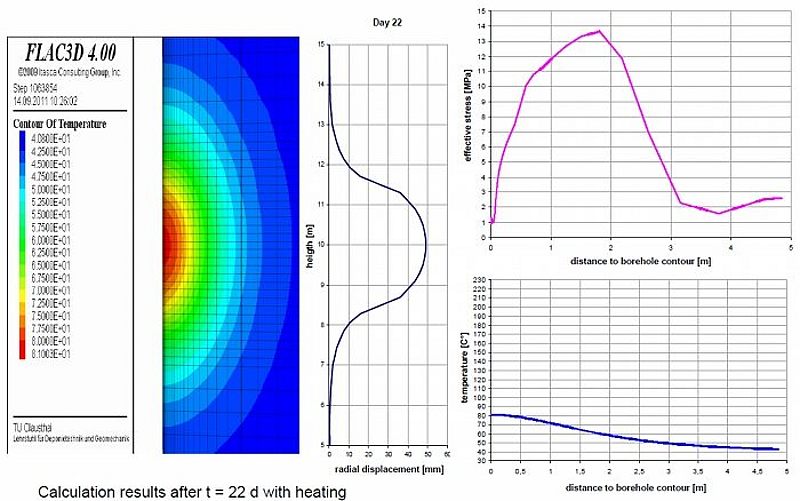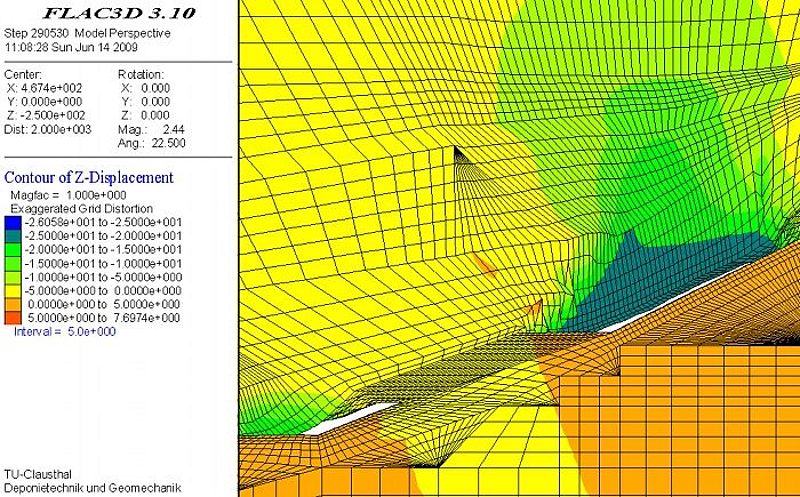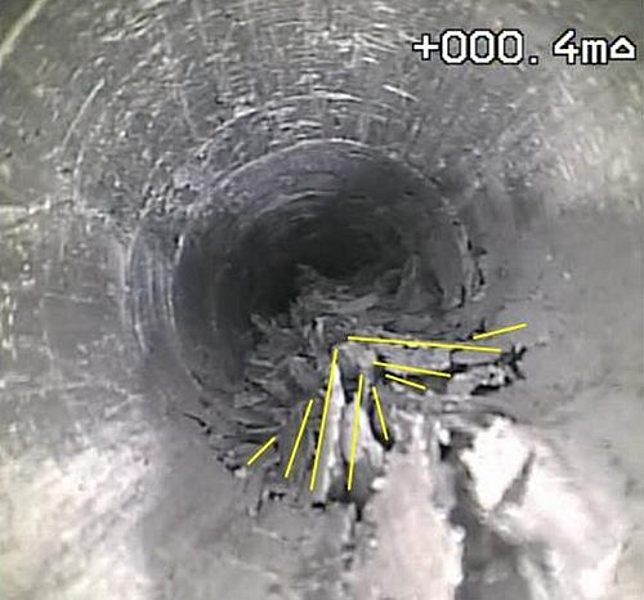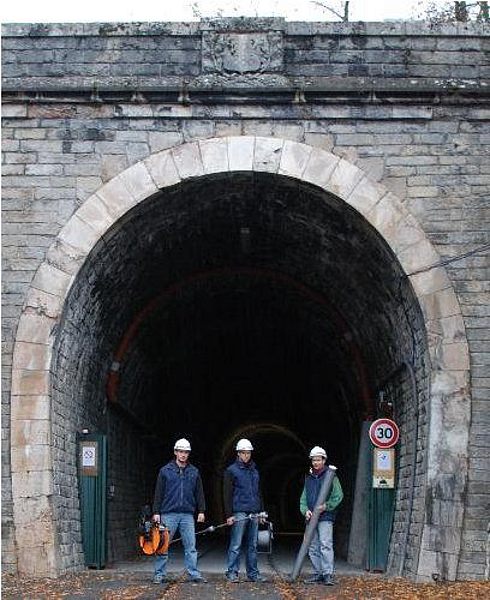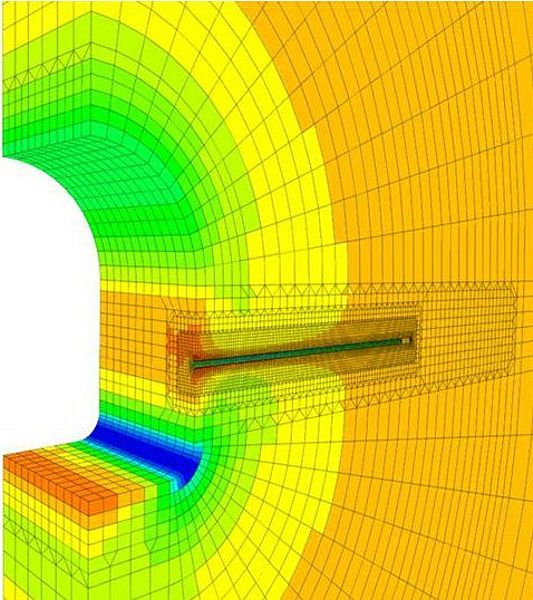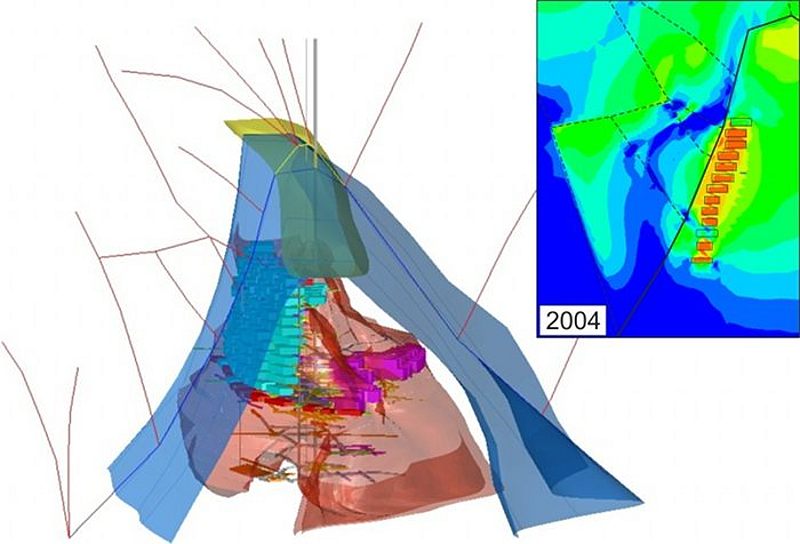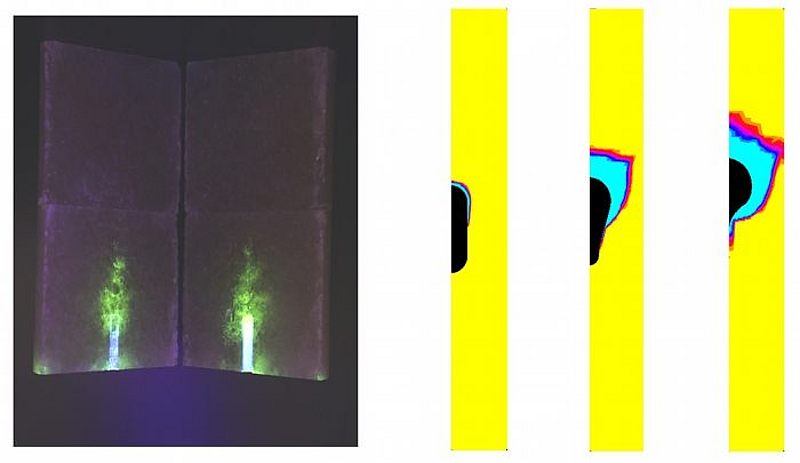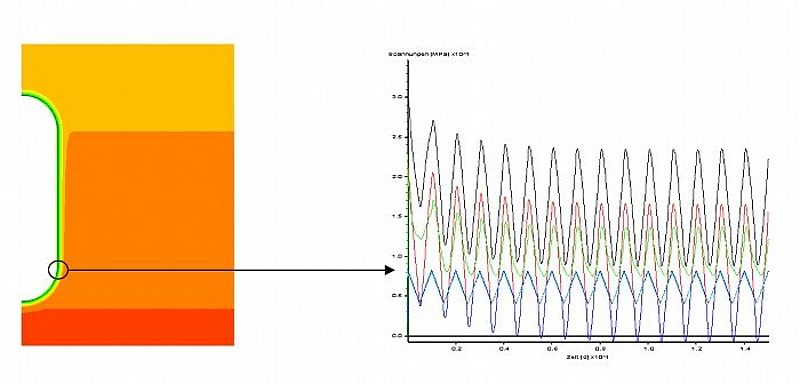Completed projects
Projektträger: Bundesministerium für Umwelt, Naturschutz, nukleare Sicherheit und Verbraucherschutz (BMUV)
Förderkennzeichen: 02E12082
Anwendungsorientierte Grundlagenforschung zur Eignung und Funktionalität eines Abdichtungselementes aus Steinsalzschnittblöcken mit Fugenfüllung zur langzeitsicheren Abdichtung eines Endlagerschachtes im Steinsalz. Im Unterschied zu Salzgrus entwickelt ein Dichtelement aus Salzschnittblöcken einen frühen Stützdruck gegen das aufkriechende Steinsalzgebirge, besitzt eine geringe Anfangsporosität und weist kurzfristig eine hohe Dichtwirkung aus (Rückbildung der Auflockerungszone). Mit dem im Forschungsvorhaben FKZ 02E11425 bautechnisch realisierten Technikumsprüfstand sollen ergänzend zu der im Forschungsvorhaben FKZ 02E11688 unter "plain-strain-Bedingungen" (konstante Radialspannung, verhinderte Axialdehnung) messtechnisch beobachteten frühzeitigen Reduktion der Permeabilität Versuche an Großprüfkörpern aus Salzschnittblöcken unter triaxialer Extensionsbeanspruchung (konstante Mantelspannung > konstante Axialspannung) realisiert werden, um die Dicht- und Tragwirkung des Systems auch unter dieser in situ relevanten THM Belastung zu analysieren. Aus versuchstechnischen Gründen (Gewährleistung des Reibverbundes zwischen Salzschnittblöcken und dem umgebenden Gebirge) ist hierbei das umgebende Steinsalzgebirge durch einen Salzbetonhohlzylinder zu substituieren, dessen mechanische Eigenschaften denen des Steinsalzgebirges weitgehend entsprechen. Durch numerische Vergleichsberechnungen (back Analysis) wird verifiziert und validiert, inwieweit das bestehende Berechnungsinstrumentarium geeignet ist oder ertüchtigt werden muss, um das laborativ erfasste Trag- und Dichtigkeitsverhalten den Anforderungen eines Langzeitsicherheitsnachweises entsprechend in Raum und Zeit derart abzubilden, dass eine Berücksichtigung bzw. Anwendung im Rahmen prädiktiver Analysen zur Standsicherheit und Integrität von Endlagern gewährleistet werden kann.
Projektträger: Bundesministerium für Wirtschaft und Energie - BMWI
Förderkennzeichen: 02E11991
Im Bereich der Endlagerung radioaktiver Abfälle im Salz- und Tonsteingebirge ist in Folge konvergenzbedingter Spannungsumlagerungen mittel- bis langfristig annähernd das gesamte die Einlagerungshohlräume, die Versatzstrecken und die Abdichtungsbauwerke umgebende Gebirge charakterisiert durch kleine deviatorische Beanspruchungen im Niveau von sv < 4 MPa. Die Kenntnis des Kriechvermögens bei kleinen deviatorischen Beanspruchungen ist daher eine wesentliche und unverzichtbare Voraussetzung für die rechnerisch zu führenden Nachweise zum Tragverhalten eines Endlagers. Die zur Ermittlung des Kriechvermögens bisher eingesetzte Versuchstechnik ist gekennzeichnet durch Dauerstandsversuche, bei denen Prüfkörper einer über die Zeit konstanten Belastung ausgesetzt werden und die resultierenden Deformationen messtechnisch ermittelt werden. Da die im Versuch resultierenden Kriechraten bereits bei sv = 10MPa in der Größenordnung der Messgenauigkeit üblicher Induktivwegaufnehmer lokalisiert sind, ist es geübte Praxis, das Kriechvermögen für kleine Deviatorspannungen durch Extrapolation einzuschätzen. Eine Möglichkeit zur Präzisierung der Kriechrate in Abhängigkeit von der Beanspruchung resultiert, wenn die Kriechversuche entgegen der klassischen Vorgehensweise nicht durch Vorgabe einer über die Versuchszeit konstanten Deviatorspannung durchgeführt werden, sondern eine konstante Kriechrate vorgegeben wird und die sich bei Erreichen der stationären Kriechrate einstellende Deviatorspannung messtechnisch ermittelt wird, da die stationäre Kriechrate von Salz- und Tongesteinen exponentiell abhängig ist von der einwirkenden Deviatorspannung, nicht jedoch die Deviatorspannung von der stationären Kriechrate. Voraussetzung für die Anwendung der vorstehend skizzierten Versuchstechnik ist es, vergleichsweise kleine Verzerrungs- bzw. Kriechraten in der Größenordnung von 1E-06d bis 1E-08d regelungstechnisch im Rahmen laborativer Versuche zu realisieren.

Projekträger: Bundesministerium für Wirtschaft und Energie sowie das Vorab der Volkswagenstiftung durch das Niedersächsische Ministerium für Wissenschaft und Kultur (vertreten durch den Projektträger Karlsruhe (PTKA))
Förderkennzeichen: 02E11849A-J
Bei TRANSENS handelt es sich um ein vom Bundesministerium für Wirtschaft und Energie und vom niedersächsischen Vorab der Volkswagenstiftung durch das niedersächsische Ministerium für Wissenschaft und Kultur gefördertes Verbundvorhaben, in welchem erstmals transdisziplinäre Forschung zur Entsorgung radioaktiver Abfälle in Deutschland betrieben wird. Hierfür sind 16 Institute bzw. Fachgebiete aus Deutschland und der Schweiz vertreten, die in vier transdisziplinären Arbeitspaketen (TAP) an zentralen Themen zur Entsorgung radioaktiver Abfälle arbeiten. Hierbei handelt es sich um:
- TAP HAFF - Handlungsfähigkeit und Flexibilität in einem reversiblen Verfahren
- TAP SAFE - Safety Case: Stakeholder-Perspektiven und Transdisziplinarität
- TAP TRUST - Vertrauen im Kontext von Technik, Unsicherheiten und Komplexität
- TAP DIPRO - Dialoge und Prozessgestaltung
Der Lehrstuhl für Geomechanik und multiphysikalische Systeme (GEMS vormals LfDG) ist hierbei im TAP SAFE und im TAP TRUST vertreten. Im TAP SAFE werden vom GEMS die räumlichen und sicherheitstechnischen Konsequenzen eines 2-Sohlen-Endlagerbergwerks untersucht sowie an der Optimierung der Darstellung von Zustandsgrößenentwicklungen im Hinblick auf die Beteiligung der interessierten Öffentlichkeit gearbeitet.
Im TAP TRUST wird vom GEMS die Thematik des längerfristigen Nahfeldmonitorings im Hinblick auf Vertrauen untersucht. Hierfür wird mit Hilfe einer Arbeitsgruppe Bevölkerung (AGBe), bestehend aus 16 an dieser Thematik interessierten Personen aus der Zivilgesellschaft, die nach sozialwissenschaftlichen Aspekten in einem systematischen Verfahren ausgewählt wurden, zusammengearbeitet, um Sichtweisen von Vertretern der Zivilgesellschaft auf das Thema Vertrauen/Vertrauensbildung zu identifizieren und die eigenen wissenschaftlichen Themen und Fragestellungen transdisziplinär zu reflektieren.
Weitere Informationen zum Verbundvorhaben TRANSENS finden Sie hier.
Projektträger: Bundesministerium für Wirtschaft und Klimaschutz (BMWK)
Förderkennzeichen: 03EI3006
Der zum Klimaschutz notwendige Übergang von fossilen auf erneuerbare Energien erfordert bei weiterem Voranschreiten in zunehmendem Maße die großtechnische längerfristige Zwischenspeicherung der erzeugten Energie, z.B. in Form von Wasserstoff und Druckluft, aber auch CO2 als Rohstoff für die Herstellung von grünem Methan. Die ökonomisch sinnvolle Umrüstung von zukünftig nicht mehr benötigten Erdgasspeicherkavernen setzt u.a. voraus, dass die bestehende Kavernenzugangsbohrung mit dem Bohrlochausbau in Bezug auf ihre mechanische Integrität einen Zustand aufweist, der eine hinreichende Einsatzfähigkeit auch noch für einen nachfolgenden jahrzehntelangen weiteren Speicherbetrieb erwarten lässt. Das Forschungsvorhaben geht davon aus, dass rechnerische Analysen und darauf aufbauende Bewertungen zum Verhalten und zur Integrität der Bohrung ergänzend in das von BVEG ( 2017) geforderte Bohrlochintegritätsmanagementsystem aufgenommen werden könnten. Besondere Aufmerksamkeit verlangt dabei unter Bezug auf die Anforderungen des Zweibarrierensystems der Bereich des Rohrschuhs der letzten zementierten Rohrtour mit komplexer Beanspruchung, aber nur begrenzter Überwachbarkeit. Daher ist ein vertieftes Prozess- und Systemverständnis in diesem Anlagenteil, der aus einem Verbund natürlicher Barrieren (Salinargebirge) und technischer Barrieren (Casing, Zementation) besteht und u.a. mechanischen, hydraulischen und thermischen Einwirkungen ausgesetzt ist, von zentraler Bedeutung für die Gewährleistung der auch langfristigen technischen Sicherheit des Gesamtsystems. Vertieft untersucht werden:
- der Dichtheitstest als zentrales Nachweiselement zum Beleg der grundsätzlichen Integrität und damit Funktionstüchtigkeit einer Bohrung
- die Auswirkung von technischen Imperfektionen in der Bohrung auf das Trag- und Abdichtungssystem sowie
- der Erhalt der Bohrungsintegrität unter zyklisch wechselnden Einwirkungen aus dem Kavernenbetrieb und der langfristigen Konvergenz
Projektträger: Bundesministerium für Wirtschaft und Energie - BMWI
Förderkennzeichen: 02E11951D
Übergeordnetes Projektziel ist die Weiterführung der im Forschungsvorhaben KOMPASS/ Phase 1 entwickelten Methoden und Strategien zur Reduzierung der Defizite bei der Prognose der Kompaktion von Salzgrusversatz. Die Weiterführung der Forschungsarbeiten ist auf folgende Einzelziele ausgerichtet:
- Weiterentwicklung von Vorverdichtungs-Laborexperimenten zur Etablierung von reproduzierbaren und vorhersagbaren Korrelationen zwischen Spannungshöhe, Spannungsdauer, Salzgrusfeuchte und der jeweiligen Zielporosität
- Durchführung von priorisierten Langzeit-Verdichtungsversuchen aus dem entwickelten systematischen Laborprogramm zur Ermittlung einer strukturierten Datenbasis über das THM-gekoppelte Verdichtungsverhalten und die isolierte Betrachtung einzelner Funktionsabhängigkeiten
- Bestimmung des Permeabilitätstensors und seiner Abhängigkeiten in den verschiedenen experimentell erreichten Zuständen des Verfüllmaterials
- Weiteres Verständnis und quantitative Verifizierung mikrostruktureller Vorgänge durch die Anwendung der im Forschungsvorhaben KOMPASS/Phase 1 vorgestellten mikrostrukturellen Methoden
- Systematische Modellvalidierung einer Vielzahl von Einflussfaktoren in Korrelation mit den Laborexperimenten und mikrostrukturellen Untersuchungen und weitere Modellverbesserungen in Bezug auf hydraulische Transporteigenschaften zur Beurteilung der Entwicklung der Barrierefunktion bei niedrigen Porositäten.
Projektträger: ELF-China-Pilot - Teilprojekt D (2020-2022)
Förderkennzeichen: 02E11850
Übergeordnetes Ziel des Verbundforschungsvorhabens ist es, geotechnische Fragestellungen zur Funktionalität von Abdichtungselementen aus Bentonit für die Endlagerung radioaktiver Abfälle in einer längerfristigen, vertieften, nachhaltigen und strukturierten Kooperation zwischen Deutschland und China zu bearbeiten. Neben wissenschaftlichen Arbeiten im Bereich laborativer, feldbezogener und numerischer Untersuchungen, sollen durch die Entwicklung und Installation eines Ausbildungs- und Traineeprogrammes Kompetenzen und Erfahrungen im Bereich der Endlagerung radioaktiver Abfälle ausgetauscht werden. Schwerpunkte des hier vom Projektpartner TUC beantragten Pilotprojektes sind
- numerisch rechnerische Reanalysen des THM Mock-up Tests von BRIUG mit dem Ziel aufzuzeigen, ob und inwieweit unter Berücksichtigung der im Versuch realisierten THMC-Einwirkungen die dokumentierten Messwerte abgebildet und nachvollzogen werden können und
- laborative Untersuchungen zur Bestimmung der 2-Phasenfluss-Eigenschaften von Bentonit durchzuführen.
Projektträger: BMWI
Förderkennzeichen: 03ET6127
Für die Speicherung erneuerbarer Energien in Form von Druckluft oder Wasserstoff können sowohl neue Kavernen gebaut wie auch bestehende Kavernen umgerüstet werden. In beiden Fällen sind sowohl die mechanische Integrität der Kaverne mit dem umgebenden Salinargebirge wie auch die mechanische Integrität der Zugangsbohrung zu belegen. Nicht betrachtet worden ist dabei bislang im Rahmen der Bohrlochauslegung das Verbundtragsystem Kaverne – Bohrloch mit der im Lauf einer jahrzehntelangen Betriebszeit durch die Kavernenkonvergenz induzierten Zusatzbeanspruchung auf den Bohrlochausbau, die zu einem stetigen Sicherheitsverzehr führt und den Erhalt der mechanischen Integrität des Bohrlochausbaus gefährdet. Mit dem Vorhaben soll mit Hilfe von laborativen Untersuchungen und rechnerischen Simulationen ein grundsätzliches Prozessverständnis zur komplexen Interaktion Kavernenbetrieb – Gebirgsdeformationen – Zusatz-Zwangsbeanspruchung des Bohrlochaus erarbeitet werden.
project executing organisation: Federal Ministry for the Environment, Nature Conservation and Nuclear Safety (BMU)
project number: 0325074
The goal of the project is to analyze the possibility of an interim storage of wind power by using underground pump storage stations in old mining areas. From the geomechanical point of view the feasibility of the foresaid idea depends on the static stability of the underground openings which must be excavated to store the water in an upper and lower basin, to connect the basins by a pressure shaft, to install the turbine and generator in an underground cavern and to guaranty the infrastructure for the all over operation by mine drifts. The static stability of underground openings depends on rock and rock mass strength, geology, tectonic elements, stress-strain and hydraulically behaviour of rock and rock mass, the primary stress field, the depth of the underground openings, the distance of excavations to old mining areas, the excavation method and last but not least the reinforcement. Taken into account the foresaid bearing values geomechanical calculations based on empirical, analytical and numerical computations are done for an underground storage system which is characterized by parallel drifts with a cross section area of about 30 square meters. Because only few respectively no informations regarding the geomechanical behaviour of the site specific rock mass are available, the calculation is defined by a very row estimation. Nevertheless it was estimated, that there are no basements which answer back the assessment, that the basic feasibility of the project is given. Regarding to the quality and amount of reinforcement needed to guaranty the static stability further investigations of the site specific situation are heavily demanded.
project executing organisation: Federal Ministry of Economics and Technology (BMWi)
project number: 02E10820
This joint project is a collaboration of several project partners with the aim to review and improve tools used for the proof of safety concerning the long-term underground disposal of heat-generating high-level radioactive waste in rock salt formations. This includes constitutive models to describe the thermal-mechanical-hydraulic coupled behaviour of rock salt. The project follows the two BMBF joint projects "Modelling of the mechanical behaviour of rock salt: Comparison of current constitutive models and procedures" (01.04.2004 to 30.11.2006) and "Comparison of current constitutive models and approaches based on 3D model calculations for long-term mechanical behaviour of real underground structures in rock salt "(01.08.2007 to 31.07.2010). In this project, founded by the German Federal Ministry of Economics and Technology (BMWi), the different modelling approaches developed by the project partners to describe the thermo mechanical behaviour of rock salt as well as its healing-ability should be analyzed. Therefore, each project partner performs coupled thermo mechanical 3D benchmark simulations with his constitutive model regarding stress, deformation, dilatancy and damage evolution and healing-effects in two real underground structures in the Asse II salt mine. The simulation results are compared with each other and with measured data. Thereby, an assessment of the capability of the different constitutive models can be given for the disposal of heat- generating radioactive waste in rock salt formations. In the Project numerous specific laboratory tests are carried out for the determination of salt-type-specific parameters as well as the verification of the constitutive models for the thermo mechanical behaviour and healing-effects in rock salt. The Chair of Waste Disposal and Geomechanics participates in this BMWi joint project with its self-developed constitutive model Lux/Wolters and performs healing-tests on rock salt specimens in its rock mechanical laboratory.
project executing organisation: Federal Ministry of Education and Research (BMBF)
project number: 02C1486
The Staßfurt location is characterized by surface subsidence and caves to the surface (sinkholes) due to collapse and drown of potash mines in the past. Solution of rock salt and potash occurs over decades of years, induced by fresh water circulation through the drown salt deposit and generates continuing surface subsidence and sinkholes. In order to predict surface development in the future geomechanical calculation based on numerical methods are done. Basic demands for a sufficient calculation of future surface subsidence are the acknowledgment of the geologic underground structure, the material behaviour of the rock mass, the geometry of underground excavations, a time schedule of mining operation events such as excavation, collapse, flooding, caves to surface, etc. and last but not least applicable criteria to decide weather or not the load bearing behaviour is leading in a rupture of rock mass. Taken into account the foresaid demands a geomechanical calculation model could be prepared and based on sensitivity studies a numerical recalculation of the measured surface subsidence could be done. Additionally to the numerical recalculation of the measured surface subsidence induced by convergence processes as well as failure processes in an old mining area it could be shown, that geomechanical calculations are applicable to verify the given data of the geological and tectonic structure as ell as the mining situation concerning the volume of underground openings caused by excavation or leaching.
project executing organisation: Federal Office for Radiation Protection (BfS)
project number: UFOPLAN-Vorhaben 3607R02596
The question has been raised as to whether restricting a survey to laboratory investigations on specimens and borehole observations, in particular for sites having sedimentary geosystems such as argillaceous rocks, allows a safety-relevant and reliable estimate of site properties both in terms of a comparison of argillaceous formations with one another as well as for com-parison with sites in saliniferous geosystems. Within the terms of this research project and against this background, consideration is given to four key issues:
- What influence do anisotropic primary rock mass stress states, rock anisotropy and joint-ing have on the load-bearing behaviour of underground openings in an argillaceous rock mass?
- Can the load-bearing behaviour of boreholes be considered as sufficiently representative for the load-bearing behaviour of drifts and emplacement chambers, and which limita-tions exist?
- Can the load-bearing behaviour of argillaceous rock mass be technically measured in boreholes, which fundamental phenomena are observed and can statements on spatial and time-dependent load-bearing behaviour be concluded?
- How should a surface-based survey programme be structured from a geomechanical viewpoint in order to draw meaningful and reliable conclusions for a comparison of sites including sites in argillaceous rock mass?
These questions are reflected within the concluding report initially by way of the results of numerical investigations into the effects of the bedding plane structure as is always present in sedimentary rocks, such as claystones. The final report also presents:the observation results of a two-year borehole observation campaign in the underground laboratory at Mont Terri near St. Ursanne (Switzerland). The key aspect here is the geomechanical influence of pore water.
project executing organisation: Federal Ministry of Economics and Technology (BMWi)
project number: 02E10427
Research project 02E10427 was elaborated with the aim of further developing the less exten-sive information about characteristics and load-bearing behaviour of argillaceous rocks in comparison to rock salt, looking in particular at the consolidated argillaceous rocks at the Tournemire location?focusing on physical modelling and numerical simulation, as well as on field and laboratory investigations. The main findings from the different aspects looked at during this research project can be summarised as follows:
- Concerning physical modelling, the strain-based combined failure and dilatancy criterion formulated in this report yields a first plausible approach to an explanation of the time-dependent development of the observed softening phenomena in the Tournemire drift sys-tem.
- Sets of own model parameters based on own mechanical laboratory investigations of Tournemire claystone material could successfully be derived.
- The usage of borehole observation equipment developed within this project (calliper probe, borehole camera, and humidity sensors) provided extensive insights into the load-bearing behaviour of the claystone rock masses at the URL locations Tournemire and Mont Terri.
project executing organisation: BFederal Ministry of Economics and Technology (BMWi)
project number: 02E11041
Research project 02E11041 is currently conducted. It's main aim is the development of a new simulation tool for the thermo-hydro-mechanical analysis of rock-mass behaviour by combin-ing the software FLAC3D and the software Tough2. In addition to the software development field investigations at the Tournemire Site (FR) and the URL Mont Terri (CH) are performed as well as laboratory investigations.
project executing organisation: Federal Ministry for the Environment, Nature Conservation and Nuclear Safety (BMU)
The Institute of Waste Disposal and Geomechanics of Technical University of Clausthal was assigned by the Institute for Applied Ecology Darmstadt to perform rock mechanical investigations within the project "Risk assessment for the longer term maintenance of Asse" in response to a request from the Federal Ministry for the Environment, Nature Conservation and Nuclear Safety (BMU). The objective of the interdisciplinary project is the investigation of possible consequences of the longer term (dry) maintenance of Asse II. In case of a flooding mining safety and radiation protection issues have to be taken into account. Especially the scenario of a flooding that might occur faster than the recovery of the waste from the ASSE II mine can be performed is investigated.
project executing organisation: Federal Ministry of Education and Research (BMBF)
project number: 02C1355
The process of pressure-driven fluid infiltration can adversely affect the load-bearing behaviour and the long-term integrity of the geological barrier in the near-field of closed underground cavities. Therefore, a sufficient understanding of the process of pressure-driven fluid infiltration as well as the development of approaches for physical modelling of the infiltration process and the development of software for its numerical simulation is of great importance in assessing the long-term safety of underground repositories for hazardous or radioactive. The aim of the BMBF-funded research project "Further development of the EDV-software INFIL for numerical simulation of pressure-driven infiltration processes of fluids into a non-permeable barrier rock mass (rock salt)" has been the further development of the computer software INFIL for numerical simulation of the pressure-driven fluid infiltration process into a primarily impermeable salt rock mass. As a basis for physical modelling as well as numerical simulation of this process, extensive laboratory studies concerning this process have been performed. In addition, the numerical software has been modified to enable the simulation of 3D-situations. This project has been successfully completed by the creation of a final report in December 2009. Based on the results of this project, afterwards the numerical software has been further improved. It is now used in the context of third-party projects related to practice.
project executing organisation: Federal Ministry of Education and Research (BMBF)
project number: 02S9082A
In Germany, the disposal of radioactive, in particular heat-generating waste has become a complex issue that cannot be solved in a pure technical and scientific way. Not only the variety of possible disposal options and variants, but also the resultant social, legal and ethical aspects necessitate the need for a comprehensive, interdisciplinary embossed multi-criteria evaluation. This project has the aim of forming a research platform for the promotion of scientific exchange and interdisciplinary collaboration between natural scientists, engineers, humanist, jurists and social scientists dealing with the disposal of radioactive waste materials to perform scientific research as well as to disciplinarily and interdisciplinarily educate and train young scientists. The Chair in Waste Disposal and Geomechanics engaged in this project with the numerical THM-coupled near-field process simulation in salt rock mass as well as in clay stone rock mass and with the development of a concept for in-situ data collection and demonstration of safety-relevant phenomena in the monitoring phase of a repository.
project executing organisation: Federal Ministry for the Environment, Nature Conservation and Nuclear Safety (BMU)
project number: 0327628
The paper deals with some geomechanical aspects of compressed air energy storage in salt caverns. One main aim of the paper is to analyse weather it is technically and economically feasible to store and restore wind power in salt caverns. Because the availability of wind is time dependent whereas the need of electric power is continuous, an intermediate storage of wind power is required. The intermediate storage of wind power basically could be done by compressing air in times with more wind power than needed for the grid and decompressing air in times with less wind power than needed for the grid. The compressed air itself potentially could be stored in salt caverns. From the geomechanical point of view this simple idea causes some problems regarding to the cavern stability. In comparison to the well known geomechanical design of natural gas storage cavities four significant differences between gas and compressed air storage in salt caverns must be pointed out:
- The cyclic turnover between fluid injection and withdrawal for compressed air energy storage is a multiple of that used by natural gas storage.
- The maximum cavern inside pressure for compressed air energy storage is limited by the allowable turbine input pressure which is in a level between 30 and 80 bar.
- Cyclic loading by compressed air energy storage requires to superimpose thermal induced and mechanical stresses.
- Compressed air energy storage is defined by the need of an ordinary operation phase with atmospheric cavern inside pressure.
To present the load bearing behaviour of CAES caverns the results of numerical investigations have been analysed taken into account the coupled thermo-mechanical calculations as well as the specific operation pattern of compressed air energy storage caverns. Special attention was given to thermal induced tensile stresses in the near field of the cavern contour and lab tests, necessary to estimate the consequences of thermal induced tensile stresses to the stability and tightness of the surrounding rock mass on the one hand and the creep behaviour of rock salt by cyclic loading on the other hand. A short summary of the project could be given by the following statement: From the geomechanical point of view a raw estimation about the load bearing behaviour is available by using design concepts learned from natural gas storage in salt caverns. To transfer the idea of compressed air energy storage into a save technical and economically optimized application, further investigations are needed to understand in detail the complex material behaviour of rock salt by cyclic mechanical and temperature loadings combined with multiple interactions to the operation pattern of CAES caverns.
Research Focus
Research focus of the chair for Geomechanics and multiphysics Systems is characterized by works dealing with the coupled thermal-hydraulic-mechanical-chemical (THMC) behaviour of underground excavations. Hereby of particular significance are investigations into the safety case, the integrity and the load bearing behaviour of repositories for radioactive waste disposal, underground waste disposal facilities for thermotoxic waste and underground energy storage sites. Important elements of investigations into the safety case and load bearing behaviour are given by laboratory tests to determine the thermomechanical-hydraulic coupled material behaviour of the rock mass (rock salt, claystone, crystalline) considering varying impacts as well as evolution, verification and validation of constitutive models used to image the static stability, tightness und integrity of underground excavations in space and time.
Leading research projects:
- load bearing behaviour of underground excavations (salt cavities, repositories, underground waste disposal facilities, tunnel, underground pump storage stations, mining excavations)
- laboratory investigations (hard rock, waste, backfill)
- evolution of constitutive models (coupled thermal-mechanical-hydraulic-chemical processes)
- evolution of software for numerical modelling (FEM, FDM)
- evolution of design and safety concepts
- geotechnical safety analysis for underground excavations





